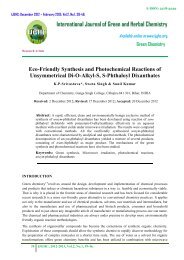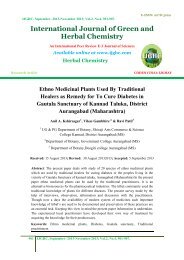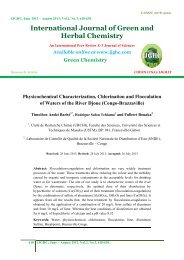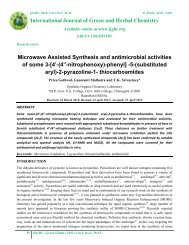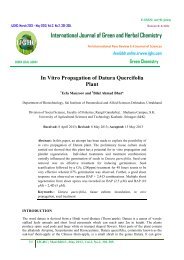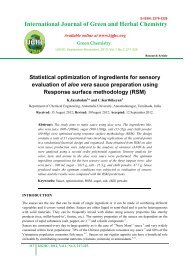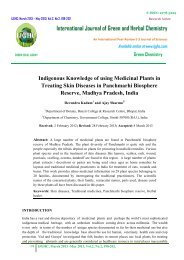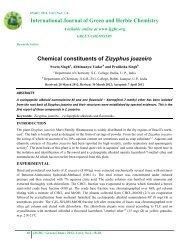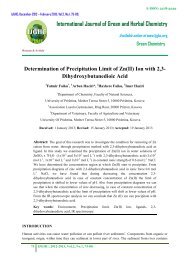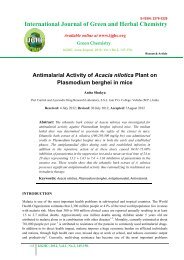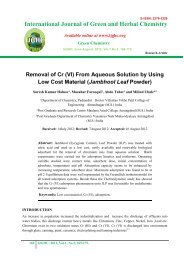Phytochemical Screening & Antibacterial activity of aqueous ... - IJGHC
Phytochemical Screening & Antibacterial activity of aqueous ... - IJGHC
Phytochemical Screening & Antibacterial activity of aqueous ... - IJGHC
You also want an ePaper? Increase the reach of your titles
YUMPU automatically turns print PDFs into web optimized ePapers that Google loves.
E-ISSN: 2278-3229<br />
International Journal <strong>of</strong> Green and Herbal Chemistry<br />
Available online at www.ijghc.org<br />
Green Chemistry<br />
<strong>IJGHC</strong>; September-November, 2012; Vol.1.No.3, 211-216<br />
Research Article<br />
<strong>Phytochemical</strong> <strong>Screening</strong> & <strong>Antibacterial</strong> <strong>activity</strong> <strong>of</strong><br />
<strong>aqueous</strong> & methanolic extract <strong>of</strong> Young & Mature<br />
leaves <strong>of</strong> Psidium guajava L. (guava)<br />
Meenakshi Vaidya<br />
Department <strong>of</strong> Botany, Mithibai College, Vile Parle (West), Mumbai 400 056.<br />
Received: 18 August 2012; Revised: 31 August 2012; Accepted: 11 September 2012.<br />
Abstract: Psidium guajava commonly called as guava belongs to family<br />
Myrtaceae. The leaf & the bark have lot <strong>of</strong> medicinal properties. Guava leaves<br />
especially have been a subject for diverse research in terms <strong>of</strong> pharmacological<br />
properties & its history in folk medicine. The leaves have been used in folk<br />
medicine as remedy for diarrhea & also for its antimicrobial properties. In the<br />
present study a comparative analysis <strong>of</strong> <strong>aqueous</strong> & methanolic extracts was done<br />
for both young & mature leaves. <strong>Phytochemical</strong> screening was carried out by<br />
standard biochemical tests, and to evaluate the possibility <strong>of</strong> novel<br />
pharmaceuticals having antimicrobial potential. The study revealed the presence<br />
<strong>of</strong> secondary metabolites like alkaloids, anthocyanins, carotenoids, essential oils,<br />
fatty acids, lectins, phenols, saponins, tannins etc. The microbial assay was done<br />
by agar cup method & MIC against the following microorganism-<br />
Staphylococcus aureus, Bacillus subtilis.<br />
Keywords: Psidium guajava, young & mature, Biochemical, antibacterial,<br />
MIC.<br />
INTRODUCTION<br />
Plants are reservoirs with healing powers. A renewed interest in screening <strong>of</strong> plants for biologically active<br />
compounds, particularly the ones which effectively intervene the human ailments. Even tens <strong>of</strong> thousands<br />
<strong>of</strong> antimicrobial compounds exist, the ability <strong>of</strong> microbes to develop resistance to even the most powerful<br />
antimicrobial compounds is amazingly rapid 1 .The most popular and attractive hypothesis is that vegetable<br />
and fruits contain bioactive compounds that have a protective effect. Plant based extracts can be extracted<br />
211 <strong>IJGHC</strong>; 2012, Vol.1, No.3, 211-216.
<strong>Phytochemical</strong>...<br />
Meenakshi Vaidya<br />
from any part <strong>of</strong> plant like seeds, roots, leaves, barks, fruits etc. One <strong>of</strong> such plant used traditionally is<br />
Psidium guajava Linn.<br />
Psidium guajava Linn. is also known as guava , belongs to the family Myrtaceae which is widely<br />
distributed in tropical and warm temperature regions <strong>of</strong> the world 2 . P. guajava contains a number <strong>of</strong><br />
phyto-constituents like tannins, essential oil, flavonoids, saponins, lectins, vitamins, fiber, fatty acids,<br />
alanine, oxalic acid, palmitic acid, quercetin, glutamic acid, d- galactose and histedine 3-10 The present<br />
work was carried out for phytochemical screening by following standard procedures and also finds out<br />
possible antimicrobial activities <strong>of</strong> the leaves <strong>of</strong> different maturity i.e. Young and mature with respect to<br />
methanolic and <strong>aqueous</strong> extracts with reference to Gram-positive bacterial strains using the agar cup<br />
diffusion method, MIC & to correlate the <strong>activity</strong> with the plant constituents present.<br />
MATERIALS AND METHODS<br />
The plant material for the current studies was collected from the campus <strong>of</strong> VIVA College, Virar (W) and<br />
which was authenticated (No. 105908).The plant material was washed, dried at 40 o C in oven for a period<br />
<strong>of</strong> seven days and then powdered.<br />
Preparation Of Extracts<br />
For Methanolic Extract: Ten grams <strong>of</strong> dried powdered material was first defatted with petroleum ether<br />
(60-80 o C) in Soxhlet apparatus for 2hr. It was then extracted with methanol for 6 h. the extract was<br />
filtered and the solvent was evaporated and reconstituted with DMSO (dimethyl sulfoxide) for further use.<br />
For Aqueous Extract: Water extract was prepared by adding ten grams <strong>of</strong> powdered plant material with<br />
distilled water in a beaker on water bath with constant stirring, filtered, concentrated.<br />
Test Organism: Staphylococcus aureus (NCIM 2654), Bacillus subtilis (NCIM 2195) were used to check<br />
for antimicrobial <strong>activity</strong>. The test organisms were sourced from NCIM, Pune.<br />
PHYTOCHEMICAL SCREENING<br />
The extracts were used for determination <strong>of</strong> phytoconstituents like alkaloids, anthocyanins, carotenoids,<br />
essential oils, fatty acids, lectins, phenols, saponins, tannins etc.<br />
Testing For <strong>Antibacterial</strong> Activity: The agar cup diffusion method was used to check the antibacterial<br />
<strong>activity</strong> <strong>of</strong> the extract. 0.2mL <strong>of</strong> standardized bacterial stock suspensions (10 8 - 10 9) colony forming units<br />
per mL was mixed with 20mL <strong>of</strong> sterile Mueller Hinton agar. The bulk seeded medium was poured into<br />
sterile Petri dishes and was left to set. For each testing organism three such plates were prepared and in<br />
each <strong>of</strong> these plates 4 cups, 8 mm in diameter were cut using a sterile cork borer and the agar discs were<br />
removed. The cups were then filled with 40 µL extract <strong>of</strong> different concentrations. Three replicates were<br />
carried out for each concentration <strong>of</strong> extract against each test organism, simultaneously addition <strong>of</strong><br />
methanol & DMSO instead <strong>of</strong> extract were carried out as controls. The plates were then incubated at 37 o C<br />
for 24 hr in upright position. After incubation, the diameters <strong>of</strong> the results and growth inhibition zones<br />
were measured, averaged and the mean values were tabulated.<br />
MINIMUM INHIBITORY CONCENTRATION (MIC)<br />
The tube dilution method was used for determination <strong>of</strong> minimum inhibitory concentration. The extract<br />
was serially diluted to give different concentration range (based on results obtained for AST for each test<br />
organism). A set <strong>of</strong> 9 sterile test tubes containing 5 mL <strong>of</strong> sterile nutrient broth was prepared, 6 such tubes<br />
were inoculated with 100 µL <strong>of</strong> bacterial culture suspension and 1 mL <strong>of</strong> plant extract and remaining two<br />
tubes were inoculated with 100 µL <strong>of</strong> bacterial culture, one containing 1 mL <strong>of</strong> DMSO & the other<br />
containing Methanol. The last tube containing only sterile nutrient broth was used as negative control. The<br />
inoculated tubes were then incubated at 37 o C for 24 hrs (for bacterial cultures) and 25 o C for 2 days (for<br />
212 <strong>IJGHC</strong>; 2012, Vol.1, No.3, 211-216
<strong>Phytochemical</strong>...<br />
Meenakshi Vaidya<br />
fungal culture). After incubation, the tubes were screened for detecting the growth which were compared<br />
against negative control. The tube which did not show any growth was taken as MIC <strong>of</strong> the extract.<br />
RESULTS AND DISCUSSION<br />
<strong>Phytochemical</strong> <strong>Screening</strong><br />
Phytoconstituent<br />
Result<br />
Tannins +<br />
Alkaloids +<br />
Flavonoids +<br />
Saponins +<br />
Essential oil +<br />
Fatty acids +<br />
Antimicrobial Susceptibility Testing (AST): methanolic & <strong>aqueous</strong> extract <strong>of</strong> Psidium guajava showed<br />
antibacterial effect on both the organisms.<br />
Table-1. <strong>Antibacterial</strong> <strong>activity</strong> <strong>of</strong> Psidium guajava leaf extracts<br />
1.1 Methanolic extract <strong>of</strong> young leaves<br />
Microorganisms<br />
Staphylococcus<br />
aureus<br />
Methanolic extracts <strong>of</strong> Psidium guajava(%)<br />
Mean inhibition zones (mm)<br />
10 9 8 7 6 5 4 3 2 1 DMSO Methanol<br />
19<br />
1<br />
7<br />
16 15 15 15 14 14 13 12 - -<br />
Bacillus subtilis 13<br />
1<br />
2<br />
12 11 - - - - - - - -<br />
1.2 Methanolic Extract <strong>of</strong> Mature leaves<br />
Microorganisms<br />
Staphylococcus<br />
aureus<br />
Bacillus subtilis<br />
Methanolic extracts <strong>of</strong> Psidium guajava(%)<br />
Mean inhibition zones (mm)<br />
10 9 8 7 6 5 4 3 2 1 DMSO Methanol<br />
17 16 16 15 15 14 14 13 13 13 - -<br />
14 13 13 12 12 11 - - - - - -<br />
213 <strong>IJGHC</strong>; 2012, Vol.1, No.3, 211-216
<strong>Phytochemical</strong>...<br />
Meenakshi Vaidya<br />
1.3 Aqueous Extract <strong>of</strong> Young Leaves<br />
Microorganisms<br />
Staphylococcus<br />
aureus<br />
Bacillus subtilis<br />
Methanolic extracts <strong>of</strong> Psidium guajava (%)<br />
Mean inhibition zones (mm)<br />
10 9 8 7 6 5 4 3 2 1 DMSO Methanol<br />
13 13 12 12 11 11 - - - - - -<br />
13 12 12 11 - - - - - - - -<br />
1.4 Aqueous Extract <strong>of</strong> Mature leaves<br />
Microorganisms<br />
Staphylococcus<br />
aureus<br />
Bacillus subtilis<br />
Methanolic extracts <strong>of</strong> Psidium guajava(%)<br />
Mean inhibition zones (mm)<br />
10 9 8 7 6 5 4 3 2 1 DMSO Methanol<br />
14 14 13 13 12 12 11 11 - - - -<br />
13 12 12 11 - - - - - - - -<br />
‘-‘Indicates no inhibition (resistant to extract)<br />
Table-2.1 Minimum Inhibitory Concentration (Young leaves)<br />
Methanolic extracts (%)<br />
Microorganism 1 0.8 0.6 0.4 0.2 - DMSO Methanol -ve<br />
Staphylococcus<br />
aureus<br />
- - + + + + +<br />
-<br />
Microorganism 7 6.8 6.6 6.4 6.2 6.0 DMSO Methanol -ve<br />
Bacillus subtilis - + + + + + + +<br />
-<br />
Table-2.2 Minimum Inhibitory Concentration (Mature leaves)<br />
Methanolic extracts (%)<br />
Microorganism 1 0.8 0.6 0.4 0.2 - DMSO Methanol -ve<br />
Staphylococcus<br />
aureus<br />
- - - + + + +<br />
-<br />
Microorganism 5 4.8 4.6 4.4 4.2 4.0 DMSO Methanol -ve<br />
Bacillus subtilis<br />
- - + + + + + +<br />
-<br />
214 <strong>IJGHC</strong>; 2012, Vol.1, No.3, 211-216
<strong>Phytochemical</strong>...<br />
Meenakshi Vaidya<br />
Table-2.3 Minimum Inhibitory Concentration (Mature leaves)<br />
Aqueous extracts (%)<br />
Microorganism 5 4.8 4.6 4.4 4.2 4.0 DMSO Methanol -ve<br />
Staphylococcus<br />
-<br />
- - - + + + + +<br />
aureus<br />
Microorganism 7 6.8 6.6 6.4 6.2 6.0 DMSO Methanol -ve<br />
Bacillus subtilis<br />
- - + + + + + +<br />
-<br />
Table-2.4 Minimum Inhibitory Concentration (Mature leaves)<br />
Aqueous extracts (%)<br />
Microorganism 3 2.8 2.6 2.4 2.2 2.0 DMSO Methanol -ve<br />
Staphylococcus<br />
aureus<br />
- - + + + + + +<br />
-<br />
Microorganism 7 6.8 6.6 6.4 6.2 6.0 DMSO Methanol -ve<br />
Bacillus subtilis<br />
- + + + + + + + -<br />
‘+’ indicates Growth <strong>of</strong> Bacteria (resistant to extract),<br />
‘-‘Indicates No Growth <strong>of</strong> Bacteria (sensitive to extract)<br />
DISCUSSION<br />
The study showed presence <strong>of</strong> phytochemicals like tannins, alkaloids, flavonoids, saponins, essential oil,<br />
fatty acids which were determined by standard procedures. <strong>Antibacterial</strong> <strong>activity</strong> was tested against<br />
S.aureus and B.subtilis and S.aureus was found to be more susceptible against both the extracts (young<br />
leaves showed better results in comparison to mature leaves) whereas B.subtilis showed moderate results<br />
for both the types <strong>of</strong> leaves for both extracts. Minimum inhibitory concentration was also carried out to<br />
find out concentration <strong>of</strong> extract causing inhibition <strong>of</strong> bacterial growth. Thus it can be concluded that<br />
maturity <strong>of</strong> leaves play an important role in determining its mode <strong>of</strong> action.<br />
REFERENCES<br />
1. K.S.Jayaraman, Manoharan S.M.,IIachezian S. (2008). <strong>Antibacterial</strong>,Antifungal and<br />
Tumor cell suppression potential <strong>of</strong> Morinda Citrifolia fruit extracts. International journal<br />
<strong>of</strong> integrative biology. 3: 44- 48.<br />
2. P.G.Wilson, O. Brien, M. Marcelle, P.A. Gadek and C. Quinn, Myrtaceae Revised: A<br />
reassessment <strong>of</strong> Infrafamilial groups. Am. J. Bot., 2001, 88: 2013-2025.<br />
3. M.L.H. Khan, J.Ahmad, A pharmacognostic study <strong>of</strong> Psidium guajava L., International<br />
Journal <strong>of</strong> Crude Drug Research, 1985, 23:95–103,<br />
4. J.Li, , F. Chen and J. Luo, Gc-MS analysis <strong>of</strong> essential oil from the leaves <strong>of</strong> Psidium<br />
guajava. Zhong Yao Cai, 1999, 22: 78-80.<br />
215 <strong>IJGHC</strong>; 2012, Vol.1, No.3, 211-216
<strong>Phytochemical</strong>...<br />
Meenakshi Vaidya<br />
5. P. Jaiarj, Anticough and antimicrobial activities <strong>of</strong> Psidium guajava leaves extract. J.<br />
Ethopharmacol, 1999 ,67: 203-212<br />
6. H.Arima, G.Danno, Isolation <strong>of</strong> antimicrobial compounds from guava (Psidium guajava<br />
L.) and their structural elucidation, Biosci Biotechnol Biochem,2002, 66(8): 1727-1730<br />
7. S.Begum, S.I.Hassan, B.S.Siddiqui, Two new triterpenoids from the fresh leaves <strong>of</strong><br />
Psidium guajava. Planta Med, 2002, 68: 1149-1152,<br />
8. A.H. Gilani, Triterpenoids from the leaves <strong>of</strong> Psidium guajava. Phytochemistry, 2002, 61:<br />
399-403<br />
9. H.N.Michael, J.Y. Salib and M.S. Ishak,. Acylated flavonol glycoside from Psidium<br />
guajava L. seeds. Pharmazie, 2002, 57: 859-860.<br />
10. M.J.Jordan, C.A. Margaria, P.E. Shaw and K.I. Goodner, Volatile components and aroma<br />
active compounds in <strong>aqueous</strong> essence and fresh pink guava fruit puree (Psidium guajava<br />
L.) by GC-MS and multidimensional GC/GC-O. J. Agric. Food Chem., 2003, 51: 1421-<br />
1426.<br />
*Correspondence Author: Meenakshi Vaidya; Department <strong>of</strong> Botany, Mithibai College,<br />
Vile Parle (West), Mumbai 400 056. Email: minakshiv@yahoo.com<br />
216 <strong>IJGHC</strong>; 2012, Vol.1, No.3, 211-216



